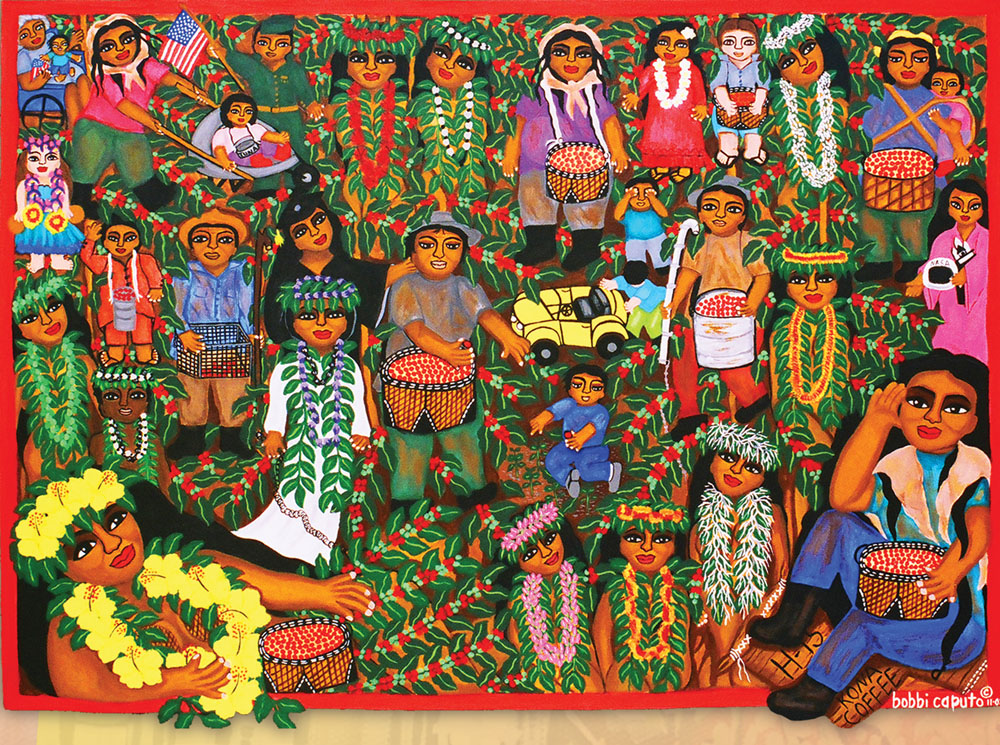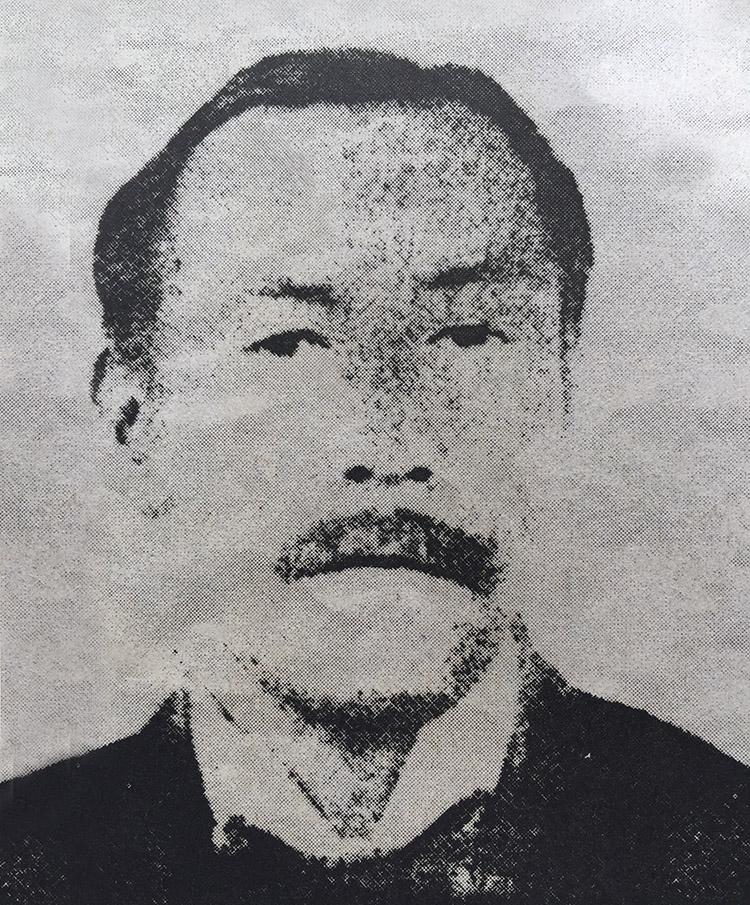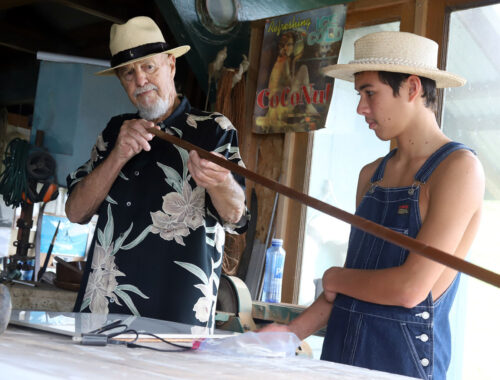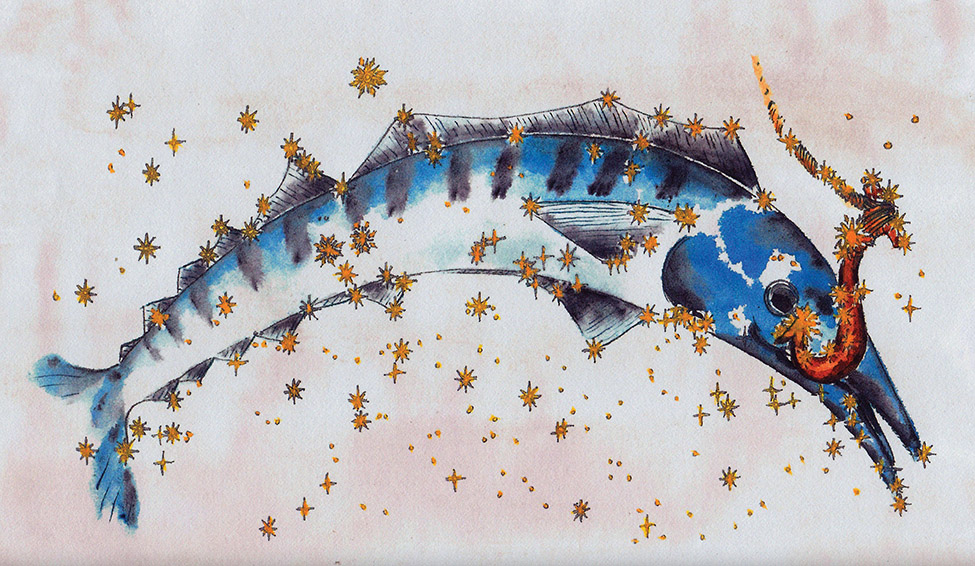
Stories in the Stars: Constellations Hawaiian Style

By Leilehua Yuen
In January, four of Leilehua Yuen’s paintings of Hawaiian constellations were put on display in the Visitor Information Station of the Ellison Onizuka Center for International Astronomy. She began research for the illustrations more than 20 years ago—collecting stories, talking with kūpuna, jotting down the stories she heard in childhood, and in the past several years, reading the Hawaiian language newspapers at nupepa.org. She has told the stories to audiences for over a decade. And now, she has begun to paint them.
As a storyteller, I am fascinated by the folklore derived from the glittering bodies dancing across the night sky. Farmers, wayfarers, kings, and priests have all used the stars as a guide to know when to plant, which direction to head, to commemorate an event, and to predict the future. I collect tales from all of these traditions and tell them again. And between the telling, I seek out the stories behind the stories. Why are these stories so important that they have been preserved for generation upon generation?
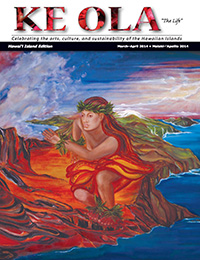
If one can find a dark place—not a somewhat dim place near houselights and streetlights; not a kind of dark place where one can still see their glow—a truly dark place with no human-made light at all, no reflected city light, and no moon glow—in that dark place, the night sky is not black. It is a dusty grey of varying intensities spangled with brilliant points of light scintillating in diamond colors; bright white, blue, yellow, and red scatter in seemingly random disarray.
Bending back one’s head to try and take in the entirety of the sky, the eye is dazzled, the senses overfilled, and the mind overwhelmed. How on earth is one to make sense of this celestial overabundance?
Humans actually are very good at sorting out masses of data and making sense of it. Every minute of every day, sounds, sights, scents, tastes, and a variety of physical pressures impact our bodies. We hear voices, see clouds, smell the exhaust of a passing car, taste coffee, feel our clothing against our skin; if we were to try and sort out all of that data every minute of every day, we would be paralyzed with information overload. Like a computer that has been tasked with too much information processing, we would simply shut down. And so we filter, sort, and categorize.
From infancy, we learn how to quickly determine what can be safely ignored, what must be attended to, and how to organize it all so that we can process the information without being overwhelmed by it. One of the tools we use is pareidolia.
Pareidolia is the human tendency to look at random groupings of things and make pictures out of them. If you have ever looked up at the clouds and seen teddy bears, winged horses, dragons, castles, or other images formed by them, you have practiced pareidolia. Pareidolia is why we see constellations and asterisms in the stars. Of course, what we see in the stars is a reflection of what we see around us in daily life, or those things that fill our own mythologies. And, not all viewers will give each star the same level of importance in choosing which will outline the constellation or asterism they see. Thus, in a grouping of, say, seven stars, some people might use the six that are closest to each other, and leave out the seventh. Others might choose only the brightest. Others might select four that make the corners of a square. And yet others might not close the square, and see a bowl instead.
In ancient Greece, the group of stars in the constellation that swung around Polaris, or the North Star, was seen as a dog, later as a dragon’s wing, and then as a young bear, Ursa Minor. The smaller asterism, or group of stars, that formed the bear’s hips and tail were known as the Little Dipper by English-speaking tribes. To the Hungarians, it was seen as the Little Goncol Cart, named for the inventor of that type of cart. In the Americas, the Aztec people saw this asterism as Twisted Foot. And to some Hawaiian people, it was a bird circling her nest.
Each of these images is associated with a story. The Greek story of Ursa Minor and Ursa Major, which can easily be found in libraries and on the Internet, tells the listener a lesson about how people should act toward each other, gives warnings about the breaking of social mores, and establishes the constellations vividly in the mind. Holding their mental image so strongly is important, as they are useful in finding north, critical for seafarers such as the Greeks, or for nomads who crossed vast deserts and plains with few distinct landmarks. Mariners, hikers, and other travelers used and continue to use Ursa Minor and the North Star as navigational aids.
In this age, we tend to think of the stories associated with these celestial images as fables and tales to amuse children. And yet at one time, they were as important to an adult as a college education is to us today. In an oral tradition, the images spilling across the dome of the night sky illustrated texts on sailing, meteorology, history, agriculture, and aquaculture. The sky was a navigational chart for the sailor, an almanac for the farmer, and a calendar for all.
The Polynesian explorers who navigated the Pacific Ocean using the stars, had never seen bears before, but they knew the wing shapes and habits of birds. The sea, sand, and rugged cliffs were not amenable to the wheel, so the arts of their inventors were used in crafting canoes, not carts. Chairs were unknown, scorpions had not yet found a way to Hawai‘i, and fishhooks were cherished: where a man went, his best fishhooks went, too. No cows or goats provided buckets of milk, but fish swam in the ocean. And so, rather than seeing carts, queens on thrones, rampaging bulls, and pails of milk, they saw flying and perching birds, a great fish leaping from the sea, and a giant hook to catch it.
The ‘iwa, Great Frigate Bird, Fregeta minor, is a pleagic avian, flying far from land over the sea. By knowing the range and habits of this bird, the Polynesian seafarer used it as one of many navigational aids. Unable to land on the water, one of ‘iwa’s habits is to seek shelter in the lee of high islands when there are storms at sea. When they gather over land, it is a good indicator of an incoming storm. Adding that observation to others, ancient people knew if it was time to pull in the canoes and secure them or secure their household against the heavy winds and rain. In good weather, ‘iwa may range some 80 km (50 mi) out to sea. A favorite food is the flying fish (mālolo). Watching the ‘iwa can show a fisherman where various fish are feeding.
One story applied to ‘Iwahine (roughly the Little Dipper) and ‘Iwakeli‘i (roughly Casseopeia) says that ‘Iwahine, the female bird, constantly circles her nest, Pūnana (Polaris). In the summertime, ‘Iwakeli‘i chases Mālolo (Schedar), diving below the horizon. In the stormy winter, he returns, flying high over Hawai‘i nei, just like any reasonable frigate bird.
One feature of Hawaiian astronomy, which often drives my students to distraction, is the many different names for one astronomical body or constellation. Seemingly confusing, this feature actually adds a great deal of precision to the field.
The Pleiades, an open star cluster in the shoulder of the constellation Taurus, is known to the kilo hōkū, the Hawaiian astronomer, by several names: Ka Huihui a Makali‘i (The cluster of Makali‘i), Huihui kōkō a Makali‘i Kau i Luna (The Net Cluster of Makali‘i Hung Above), Nā Kā a Makali‘i (The Bailer of Makali‘i), Nā kōkō a Makali‘i (The Net of Makali‘i), Nā Wahine a Makali‘i (The Wives of Makali‘i), Ke Aweawe Makali‘i (The Makali‘i Stars Stuck Together), Ka Lālani a Makali‘i (The Makali‘i Line), Huihui (Cluster, Group), and Kūpuku (Clustered). In some traditions, the Pleiades is also called Makali‘i, and there are also traditions that assign that name to Aldebaran.
What does such an abundance of names tell us? First, it tells us that the star, planet, or group of stars is very important to a lot of people. The Pleiades is important to the traveler as a navigational feature. The variety of names indicates, I believe, the altitude and angle of the cluster, which is critical information to a navigator.
One translation for Makali‘i is “Eyes of the Chief,” and that was the name of the head navigator of Hawai‘iloa, a great voyaging chief. If we look at the cluster when it is first rising above the horizon, it could look a bit like a woman standing upright. Or perhaps it is a group of women, Nā Wahine a Makali‘i.
In either case, soon the sail of the husband’s canoe comes into sight, and Makali‘i (Aldebaran), the navigator, sails into view. What better reason to journey forth than to find a wife? As the cluster rises overhead, the stars begin to look like a bailer, an important commodity, indeed for those who spend their lives on the sea.
In fact, a number of Polynesian legends center on magical women who take the form of a beautifully carved bailer floating in the ocean. Caught and claimed by the right man, the bailer becomes a beautiful woman who agrees to marry him. And so the Makali‘i line continues down to the sea. Makali‘i and his wives rise a bit north of due east, and pass directly overhead on their way to the sea, where they will set to the south of due west.
For the traditional farmer, on Hawai‘i Island, the November 17 rising of the Pleiades marks the approximate start of the rainy season. Makali‘i was a great navigator and steersman and also an agronomist (expert farmer). Indeed, we find that around the world the Pleides is associated with farming. In Hawai‘i, the evening rising of those stars is associated with the return of the all-important rainy season.
Other chiefs have also been named Makali‘i. Among them is the father of Kamapua‘a, the pig demigod also associated with rain and fertility. At the other end of the spectrum is a greedy Chief Makali‘i, who figures into a story from the Kona Coast. In this story, Makali‘i is translated as “tiny eyes,” which is a euphemism for “greedy” and refers to a chief who taxed the people into poverty during a drought. In this story, ‘Iole, the Hawaiian rat, saved the people from starvation by chewing through Huihui kōkō a Makali‘i Kau i Luna. The net burst open and all the food that the evil Chief Makali‘i had placed in it fell back to earth. Hidden within this story may be a record of the extreme El Niño conditions of 1640.
Whatever historical events may be encoded into the story, for myself, when the net hangs over the western sea, I enjoy thinking of Aldeberan as the right ear of ‘Iole, ε Tauri as his left ear, θ1 and δ his eyes, and γ Tauri his pointy little nose. His body is to my left, and Orion’s bow makes his tail. If I look closely at the Pleiades, which ‘Iole is also eyeing, I see where our heroic little rat bit through the side of the net, making it hang lopsided as it falls below the horizon. ❖
Contact writer Leilehua Yuen: KaaheleHawaii.com
Bibliography
- Beckwith, Martha W. Hawaiian Mythology. Honolulu: UH Press, 1970. (Originally published in 1940 by Yale University Press.)
- Cartwright, Bruce. “The Legend of Hawaii-Loa.” Journal of the Polynesian Society. Vol. 38: 1929. 105-121.
- Emerson, N. B., “Long Voyages of the Ancient Hawaiians,” Papers of the Hawaiian Historical Society, May 18, 1893 (No. 5) 5-13.
- Finney, Ben. From Sea to Space. Palmerston North, NZ: Massey University, 1992.
- Fornander, Abraham. Hawaiian Antiquities and Folklore. Bishop Museum Memoirs, Vols 4, 5, and 6. Honolulu: Bishop Museum Press, 1916-1920.
- Green, Laura; edited by Martha Warren Beckwith. Folk-Tales from Hawaii. Poughkeepsie, New York: Vassar, 1926.
- Handy, E.S. Craighill. Marquesan Legends. Honolulu: Bishop Musuem Press, 1930.
- Handy, E.S. Craighill. The Native Culture in the Marquesas. Honolulu: Bishop Musuem Press, 1923.
- Henry, Teuira et al. Voyaging Chiefs of Havai‘i. Honolulu: Kalamaku Press, 1995. A collection of voyaging traditions from across Polynesia.
- Irwin, Geoffrey. The Prehistoric Exploration and Colonization of the Pacific. Cambridge, UK: Cambridge University Press, 1992.
- Johnson, Rubellite K. From the Gills of the Fish: The Tahitian Homeland of Hawaii’s Chief Mo‘ikeha.
- Kalakaua, David. The Legends and Myths of Hawaii. Rutland, Vermont: Tuttle, 1972. Originally published in 1888.
- Kamakau, Samuel Manaiakalani. Tales and Traditions of the People of Old / Na Mo‘olelo a ka Po‘e Kahiko. Honolulu: Bishop Museum, 1993.
- Kepelino’s Traditions of Hawaii. Honolulu: Bishop Museum, 1932.
- Kāne, Herb Kawainui. Voyagers. Honolulu: Whalesong, 1991.
- Kirch, Patrick Vinton. Feathered Gods and Fishhooks: An Introduction to Hawaiian Archaeology and Prehistory. Honolulu: UH Press, 1987.
- Lewis, David. We, the Navigators: The Ancient Art of Landfinding in the Pacific. 2nd Edition. Honolulu: UH Press. 1994.
- Lindo, Cecilia Kapua and Nancy Alpert Mower. Polynesian Seafaring Heritage. Honolulu: Kamehameha Schools, 1980.
- Tobin, Jack A. Stories from the Marshall Islands, Bwebwenato Jān Aelōn Kein. Pali Language Texts, Micronesia
- Ka Hae Hawai‘i. Buke 5, Ano Hou.—Helu 36, Aoao 147; Dekemaba 5, 1860 – 5 Kekemapa 1860
- Nupepa Kuokoa; Buke 4, Helu 2; 12 Ianuali 1865
- Nupepa Kuokoa; Buke 1, Helu 51, 16 Nowemapa 1862
